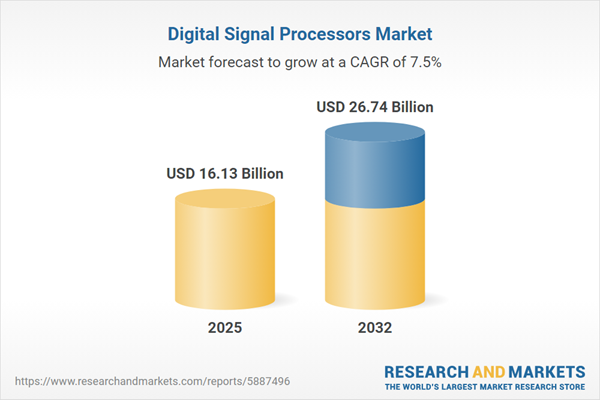Speak directly to the analyst to clarify any post sales queries you may have.
The digital signal processors market is undergoing substantial evolution, with technology and user demands shaping new growth trajectories across sectors. Senior decision-makers seeking actionable intelligence will find detailed insights into market structure, trends, risk factors, and competitive shifts, all aimed at enabling confident, forward-looking strategies.
Market Snapshot: Digital Signal Processors Market Analysis
The Digital Signal Processors Market grew from USD 14.99 billion in 2024 to USD 16.13 billion in 2025. It is expected to continue growing at a CAGR of 7.50%, reaching USD 26.74 billion by 2032. This upward momentum reflects rising adoption in next-generation systems across industries, underscoring the pivotal role of digital signal processors in driving efficiency, real-time analytics, and advanced control functions.
Scope & Segmentation: Comprehensive Overview of Market Coverage
- End Use Industry: Aerospace and Defense (including electronic warfare, flight control, radar imaging), Automotive (covering advanced driver assistance systems, infotainment, powertrain control), Consumer Electronics (audio devices, smart home, video devices), Industrial (factory automation, process control, robotics), Telecom (broadband access, mobile handsets, wireless infrastructure).
- Processor Type: Fixed Point; Floating Point (double precision, single precision).
- Applications: Audio Processing (audio codecs, noise cancellation, voice recognition), Communication (5G, LTE, WiFi, Bluetooth), Motor Control (automotive, industrial), Radar Imaging (ground penetrating radar, synthetic aperture radar), Video Processing (augmented reality, image recognition, video compression).
- Processor Speed: High speed, medium speed, low speed.
- Core Count: Multi-core (dual, quad, octa) and single-core configurations.
- Geography: Americas (United States, Canada, Mexico, Brazil, Argentina, Chile, Colombia, Peru), Europe, Middle East & Africa (United Kingdom, Germany, France, Russia, Italy, Spain, Netherlands, Sweden, Poland, Switzerland, United Arab Emirates, Saudi Arabia, Qatar, Turkey, Israel, South Africa, Nigeria, Egypt, Kenya), Asia-Pacific (China, India, Japan, Australia, South Korea, Indonesia, Thailand, Malaysia, Singapore, Taiwan).
- Key Companies: Texas Instruments, Qualcomm, Analog Devices, NXP Semiconductors, Broadcom, STMicroelectronics, Infineon Technologies, Renesas Electronics, Microchip Technology, Cirrus Logic.
Key Takeaways for Decision-Makers
- Heterogeneous multi-core and AI-accelerated architectures are fueling parallel processing capabilities, allowing deployment in increasingly complex and real-time applications.
- Advanced materials such as gallium nitride and silicon carbide are propelling higher operating frequencies and improved thermal efficiency, enabling broader industrial and mobile deployment.
- Verticals like automotive, aerospace, and consumer electronics are seeing rapid integration of DSP technology for tasks ranging from autonomous navigation to advanced audio and video processing.
- Companies are leveraging R&D, strategic partnerships, and mergers to advance their competitive positions and respond to sector-specific requirements.
- The shift towards integrated platforms also means signal processing workloads across network edge, mobile, and industrial environments are handled with greater agility and resource optimization.
Tariff Impact: Navigating Regulatory Shifts in Supply Chain
Recent United States tariff measures have introduced increased costs to semiconductor imports, pressuring supply chains and reshaping sourcing strategies across global and regional markets. Manufacturers are responding by diversifying suppliers, exploring nearshore production, and renegotiating contracts with built-in risk mitigation. Simultaneously, domestic incentive programs are supporting select players, altering the competitive landscape and prompting closer examination of procurement resilience and operational agility.
Methodology & Data Sources
The research leverages a robust blend of primary and secondary methodologies. Direct interviews with industry executives, engineers, and procurement specialists provide firsthand validation, while secondary sources include deep reviews of technical papers, patents, and regulatory updates. Stringent data triangulation ensures the integrity of segmentation and trend analysis.
Why This Report Matters
- Enables strategic planning by delivering a holistic view of technology trends, supply chain risks, and emerging applications for senior leaders.
- Supports decision-makers in benchmarking against global competitors and identifying new expansion opportunities.
- Equips organizations with the insights to align technical investments with evolving regulatory, geographic, and end-user dynamics.
Conclusion
This report empowers industry leaders with critical intelligence on digital signal processors, technological shifts, and evolving policy environments. Accessing timely, in-depth market perspectives supports resilient, future-ready strategies in this high-stakes ecosystem.
Additional Product Information:
- Purchase of this report includes 1 year online access with quarterly updates.
- This report can be updated on request. Please contact our Customer Experience team using the Ask a Question widget on our website.
Table of Contents
3. Executive Summary
4. Market Overview
7. Cumulative Impact of Artificial Intelligence 2025
Companies Mentioned
The companies profiled in this Digital Signal Processors market report include:- Texas Instruments Incorporated
- Qualcomm Incorporated
- Analog Devices, Inc.
- NXP Semiconductors N.V.
- Broadcom Inc.
- STMicroelectronics N.V.
- Infineon Technologies AG
- Renesas Electronics Corporation
- Microchip Technology Incorporated
- Cirrus Logic, Inc.
Table Information
| Report Attribute | Details |
|---|---|
| No. of Pages | 182 |
| Published | October 2025 |
| Forecast Period | 2025 - 2032 |
| Estimated Market Value ( USD | $ 16.13 Billion |
| Forecasted Market Value ( USD | $ 26.74 Billion |
| Compound Annual Growth Rate | 7.5% |
| Regions Covered | Global |
| No. of Companies Mentioned | 11 |









